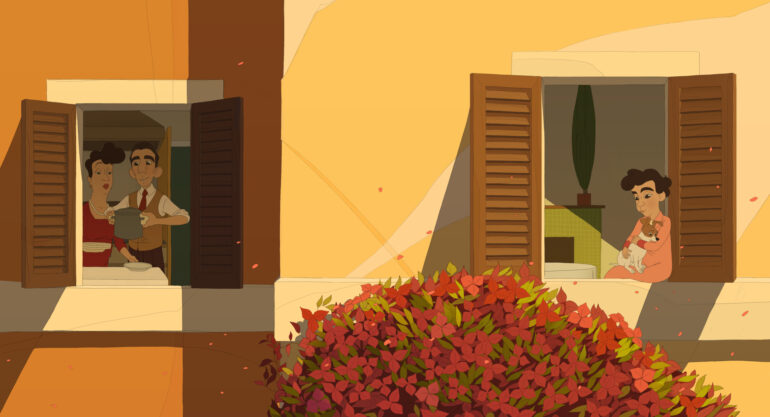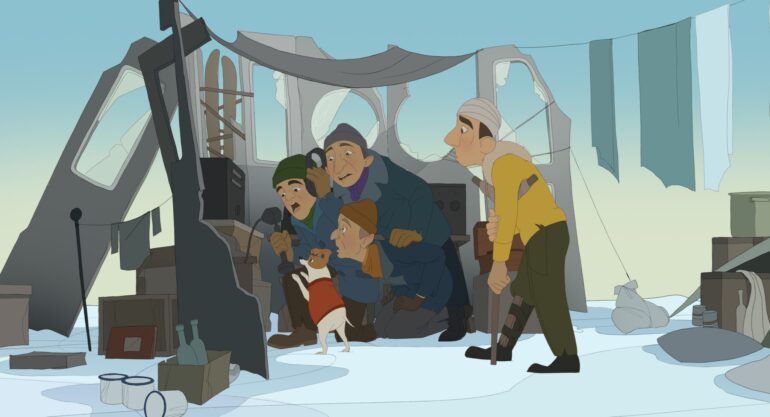WRITTEN BY: Annika Pham
The Norwegian/Belgian animated film opened in Norway to rave reviews on Friday and had its international launch at L.A.’s Animation is Film Festival on Sunday.
The Swedish release via Folkets Bio is set for Friday October 28.
"Titina" is a magnificent cartoon with a historical twist, where hand-drawn animation gives a poetic touch that digital animation often lacks”, said reviewer Birger Vestmo in NRKP3, who gave the film a maximum 5 stars, while Dagbladet called it a “cinematic feast”, giving a full 6 stars, just as Cinema and Aftenposten.
The film is the untold true-ish story of ‘Titina’, the little terrier who conquered the North Pole on an airship with Italian explorer Umberto Nobile and Norway’s legendary Roald Amundsen in 1926.
Told with humour through the eyes of the little dog, Næss’s first feature-length animated film is both a tale of triumph and defeat. We see Italian airship engineer Umberto Nobile, who enjoys a quiet life in Rome with his beloved dog Titina. One day, Norwegian explorer superstar Roald Amundsen contacts him and orders an airship to conquer The North Pole.
Nobile seizes the opportunity to go down in history. He brings Titina along, and the unlikely trio sets out on an expedition to the last undiscovered place on Earth. Their quest is successful but, in the aftermath, the two men start to quarrel over the glory.
The NOK 80m film mixes 2D animation and unique archive material. It was produced by Tonje Skar Reiersen and Lise Fearnley for Norway’s Mikrofilm (Oscar-winning studio with The Danish Poet), with Viviane Vanfleteren of top Belgian studios Vivi Film (The Triplets of Belleville, The Secret of Kells).
The film supported by Nordisk Film & TV Fond was licensed to more than 25 territories by Les Film du Losange including Benelux (Lumiere), Italy (BIM) and the Baltics (Estin Film).
Besides Norsk Filmdistribusjon handling the Norwegian release and Folkets Bio the Swedish release, Titina will open in Finland via Filmkompaniet and in Iceland via Sena.
Kajsa you had quite a lot of guts to direct your first feature length animated film based on original and historical material. Why did you choose the airship expeditions to the North Pole of the late 1920s and when did you first start working on the project?
Kajsa Næss: We started eight years ago. In Norway Roald Amundsen was of course a national hero. I accidentally came across the airship expedition of 1926. I didn’t know about it as I’m not a polar nerd. I then researched and found out more about it through beautiful film footage and images. The airships were from another world, so big, yet so fragile. They were revolutionary at the time and suddenly lost their appeal.
I also discovered that the Italian engineer Umberto Nobile insisted on bringing his little terrier Titina on both his ‘Norge’ airship expedition with Amundsen in 1926 and his own ‘Italia’ expedition in 1928.
For any Norwegian, it is very strange to bring this type of dog on an arctic expedition-you either have a dog to make it work or…eat it!!
Then of course the clash between Amundsen and Nobile about who was to claim the victory of reaching the North Pole first in 1926 with the airship ‘Norge’, was interesting to portray, as well as the men’s destinies.
After Nobile’s second expedition to the North Pole in 1928 that ended up in a disaster [the airship crashed, 8 men died and Nobile had to be rescued with some survivors], Amundsen tried to take part in the rescue operations and disappeared. No one knows what happened to him.
As for Nobile, after that, his life went downhill. Once back in Italy he lost his job, the Fascists who had sponsored his expeditions, didn’t like him because he was a communist. So he went to Russia and only returned to Italy in 1943. He died in Rome in 1978.
Was it you who approached Per Schreiner with the idea for the film?
KN: Yes. I had never written a script for a feature before so I went to Per. Initially I thought I could do a 20-minute film as I hadn’t made long features. But Per said-why bother? Let’s just go straight to a feature length.
Through the dog Titina, there is a lovely comic relief to this rather serious story of two men fighting for glory in extreme weather conditions. How did you approach the humour with Per who showed a great talent for black comedy in The Bothersome Man…
KN: Yes early on, we decided to tell the story through the dog’s viewpoint. We also wanted to make Amundsen and Nobile’s quarrel childish, and them as two selfish guys with flaws. We had in mind Jacques Tati’s films as a reference, notably Monsieur Hulot. Seeing the other characters through his glance often makes them absurd, and this was the effect that we wanted to have with Titina’s perspective on the two explorers.
Was it difficult to create a smooth transition from animation to archive material and how did you use the real footage of the airship expeditions as a narrative tool?
KN: A lot of people were sceptical about that. But we had a clear vision of what we wanted to do. We had a lot of archive footage, and many ways to go in and out of it. We felt that for the part set in Rome in 1978, having Titina and Nobile sitting in their apartment and remembering the North pole expeditions through original documentary material was a great way to introduce the real footage to viewers. Basically, the documentary material would be ‘the official story’ and the animation part, Noble and Titina’s memories.
Then we used the archive footage in the script to save on animation work. For instance, instead of drawing the airship landing in Svalbard, which would have been too expensive, we used the magnificent true images as part of the narration.
Elsewhere, the archive material helped us to build the characters’ personality in the animated parts.
Between Mikrofilm and Vivi Film, who took charge of the storyboarding, character design and various phases of the animation work?
KN: We did the pre-production at Mikrofilm - storyboarding, character/background design and music in Norway. I worked very closely with Belgian animation director Marie-Laure Guisset and the animation team in Brussels and Ghent. It was great to be there with them the whole time.
Could you explain your choice for the animation style?
KN: We didn’t want flexible animation, but a classical 2D animation and focus on the story, the characters so that the audience would identify to them, understand their emotions without too much movement. That was quite innovative in animation where you usually have lots of movement in every frame.
Then when art director Emma McCann came on board, she understood that for the colours, we wanted a clash between Italy -warm colours in the yellow-orange tones, and Norway-in the blue and cold colours palette.
What was the most challenging but also the most rewarding with this film?
KN: I think it is harder and harder to make films for kids, as the target audience is often quite narrow. Financiers are reluctant to give money to kids’ movies that are serious, although I grew up with films such as My Life as a Dog, that left a mark on me.
I think we should not underestimate kids’ ability to understand things, including death. This is also part of our Nordic storytelling tradition.
We did test screenings in Norway and parents came to me saying: ‘I’m happy you did an animation film where we could actually see someone die’. I think the mix of humour, serious, emotional elements and historical background makes the film compelling to all ages, including adults who rarely watch animation films on their own.
To see the trailer CLICK HERE.
What are you doing next?
KN: I have a short film coming. But Titina is just coming out around the world and I’m supporting its worldwide launch.


